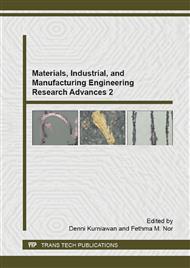[1]
M. German, Powder Metallurgy of Iron and Steel (Ed), John Wiley and Sons, New york, NY, (1997).
Google Scholar
[2]
R.F. Conley, Practical Dispersion, A guide to Understanding and Formulation Slurries (Ed) Wiley-VCN, New York, NY, (1996).
Google Scholar
[3]
Y. I. Kim, J. H. Kim, J. K. Lee and D. Kim, Analysis of 3D Geometry and Compressive Behavior of Aluminum Open Cell Foam Using X-ray Micro CT, Trans. Mater. Process, 20 (2011) 518-523.
DOI: 10.5228/kstp.2011.20.7.518
Google Scholar
[4]
K. O. Oh, E. S. Lee, J. S. Bae, M. J. Jang, R. Poss, B. Kieback, G. Walther and B. Kloeden, Met Foam. (2011).
Google Scholar
[5]
D.T. Queheillalt, D.D. Hass, D.J. Sypeck, H.N.G. Wadley, Synthesis of open-cell metal foams by templated directed vapor deposition, J. Mater. Res. 16 (2001) 1028–1036.
DOI: 10.1557/jmr.2001.0143
Google Scholar
[6]
Y. Boonyongmaneerat, D.C. Dunand, Ni-Mo-Cr Foams Processed by Casting Replication of Sodium Aluminate Preforms, Adv. Eng. Mater. 10 (2008) 379–383.
DOI: 10.1002/adem.200700300
Google Scholar
[7]
O. Smorygo, V. Mikutski, A. Leonov, A. Marukovich, Y. Vialiuha, Nickel foams with oxidation-resistant coatings formed by combustion synthesis, Scr. Mater. 58 (2008) 910–913.
DOI: 10.1016/j.scriptamat.2008.01.014
Google Scholar
[8]
D.T. Queheillalt, Y. Katsumura, H.N.G. Wadley, Synthesis of stochastic open cell Ni-based foams, Scr. Mater. 50 (2004) 313–317.
DOI: 10.1016/j.scriptamat.2003.10.016
Google Scholar
[9]
K.A. Khor, L.G. Yu, O. Andersen, G. Stephani, Effect of spark plasma sintering (SPS) on the microstructure and mechanical properties of randomly packed hollow sphere (RHS) cell wall, Mater. Sci. Eng. A 356 (2003) 130–135.
DOI: 10.1016/s0921-5093(03)00111-4
Google Scholar
[10]
H. Choe, D.C. Dunand, Mechanical properties of oxidation-resistant Ni–Cr foams, Mater. Sci. Eng. A 384 (2004) 184–193.
DOI: 10.1016/s0921-5093(04)00814-7
Google Scholar
[11]
H. Choe, D.C. Dunand, Synthesis, structure, and mechanical properties of Ni–Al and Ni–Cr–Al superalloy foams, Acta Mater. 52 (2004) 1283–1295.
DOI: 10.1016/j.actamat.2003.11.012
Google Scholar
[12]
Andersen O, Waag U, Schneider L, Stephani G, Kieback B, Novel Metallic Hollow Sphere Structures, Adv. Eng. Mater, 2 (2000) 192-195.
DOI: 10.1002/(sici)1527-2648(200004)2:4<192::aid-adem192>3.0.co;2-#
Google Scholar
[13]
Sumitomo Electric, Japan. Product data sheet of Celmet, (1986).
Google Scholar
[14]
Neumann P. Metal foams and porous metal structures (Ed). In: Banhart J, Ashby MF and Fleck NA. Int. Conf., Bremen, Germany, 14–. 16 June. Bremen: MIT Press – Verlag, 1999, pp.167-176.
Google Scholar
[15]
B.A.A.L. Van Setten, M. Makkee, J. A. Moulijn, Science and technology of catalytic diesel particulate filters, Catal. Rev. –Sci. Eng, 43 (2001) 489–564.
DOI: 10.1081/cr-120001810
Google Scholar


